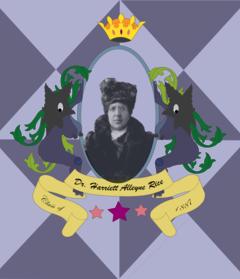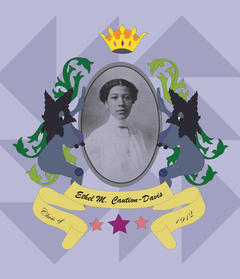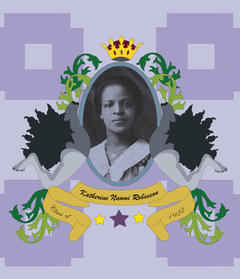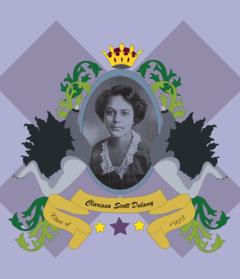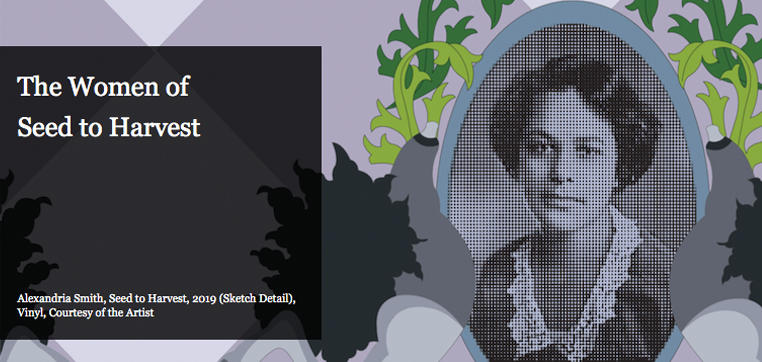
The Women of Seed to Harvest
Curated by Elana Bridges, Class of 2020
2019 Davis Museum Summer Intern
2018-2019 Davis Museum Curatorial Assistant
This online exhibition was completed as an assignment for Professor Nikki Greene’s seminar
ARTH 316: The Body: Race and Gender in Contemporary Art
Special Thanks to College Archivist Rebecca Goldman and the Wellesley College Archives

Commemorating the First Black Graduates of Wellesley College
In Seed to Harvest, the third commission for the Davis Museum’s Windows Invitational, American artist Alexandria Smith commemorates some of the first Black graduates of Wellesley College. Curated by Lisa Fischman, Ruth Gordon Shapiro '37 Director, the Windows Invitational prompts artists to transform the floor-to-ceiling windows of the lobby and courtyard plaza of the Davis Museum. Smith, now Head of Painting at the Royal College of Art in London and formerly Assistant Professor of Painting at Wellesley College (2016-2019), completed the work in September 2019, and it will remain on view until June 2021. In vinyl applied to the windows, Smith’s visual symbology embellishes original photographic portraits of Dr. Harriett Alleyne Rice (Class of 1887), Ethel M. Caution-Davis (Class of 1912), Katherine Naomi Robinson (Class of 1922), Clarissa Scott Delany (Class of 1923), and Jane Bolin (Class of 1928). This online exhibition complements and archives Seed to Harvest by presenting the biographies of these five Black women.
Smith is a mixed media visual artist whose work explores themes of hybrid identities, domesticity, sexuality, time, and space. She earned her BFA in Illustration from Syracuse University, MA in Art Education from New York University, and MFA in Painting and Drawing from Parsons The New School for Design. Smith has explained that through “interweaving memory, autobiography and history, my mixed media work explores the transformative girlhood experiences that shape the women we become and illuminates the complexities of Black identity.” She frequently revisits older works when creating something new and, in Seed to Harvest, Smith drew symbols, such as the abstracted body parts within each of the portraits, from her wider oeuvre to reference Black femininity.
As one of two Black women in the Art Department during her tenure at Wellesley College, Smith related to the first Black graduates who were also frequently the only people of color in the spaces they occupied on campus. She was surprised to only learn of their specific stories years after arriving at Wellesley. In creating this installation on campus, Smith shares their often-forgotten narratives and memorializes their important contributions to Wellesley and to the world. After graduating from Wellesley, these women became pioneers in their respective fields. Smith celebrates their shared sisterhood and identities as both Wellesley graduates and Black women by using both hand-drawn and computer techniques to create portraits complete with invented family crests. Seed To Harvest demonstrates that despite facing adversity to become some of the first Black women in their fields, these women are much more than their accomplishments.

Alexandria Smith, a Lure, 2018, Artwork Credit: Courtesy of the Artist
To see an interview with the artist, follow this link.
The Graduates
Smith borrows the name for this installation from groundbreaking science fiction writer Octavia Butler’s Patternist series, also known as Seed to Harvest. These novels by Butler form a mythic tale of the transformation of a civilization, spanning from the ancient Egyptian period to the far future. Butler’s novels explore themes of race, slavery, early civilization, history, and the creation of alternative realities. Smith draws from Butler’s framework to envision the “seeds” that these five Black women planted on their journey to get an education to be better prepared to fight for social justice in the medical, legal, and education fields. Among the first Black graduates of Wellesley, they paved the way for all who would follow in their path.
In reaching back to the past to uncover their narratives, Smith envisions a reality where these women are royalty by giving them crowns. Their connections to Wellesley College also have been concretized in these portraits by crests that identify each alumna and her class year. The backgrounds of the portraits feature quilt patterns that were used to convey messages along the Underground Railroad during the early to mid-nineteenth century in North America, when there were two stops in the town of Wellesley. Visually representing the themes within Butler’s Seed to Harvest novels, Smith uses the installation space as a site of memory and history by harkening back to Black resistance against slavery to offer historical context for the experiences of the first Black graduates of Wellesley College. The United States abolished slavery in 1863, although enslaved people in Texas were only notified of their freedom two years after President Lincoln issued the Emancipation Proclamation. Twenty-four years following the end of slavery, Dr. Harriet Rice graduated from Wellesley College.
Despite being accepted to the institution, the experiences of these five Black graduates at Wellesley College were no different than the experiences of Black people throughout the United States during the nineteenth and twentieth centuries. Their exceptional accomplishments while at Wellesley despite the immense racial discrimination they faced on campus signify the immense determination and courage it took to envision themselves in positions deemed too white—and in their later professional lives, too white and too male. After graduating in the top of their classes, excelling in varsity sports, and publishing literature on campus, these women left Wellesley with an education and skills that they used to fight injustices in the United States and beyond. In order to accomplish all that they did, they had to envision a world that did not yet exist. Whether becoming the first Black graduate of Wellesley College or the nation’s first Black woman to join the New York City Bar Association, a young woman had to picture herself in those spaces. The women visualized themselves thriving in racist white spaces—and changing those spaces. In Seed to Harvest, their images celebrate that vision and their successes.
Click on the images below to learn about each alumna featured in Seed to Harvest.
